[ad_1]
It’s uncommon, but not unheard of, for notable QBs to change teams — via trade, free agency, or waiver claim — at the 11th hour or during a season. Here are the top instances of QBs relocating late and making an impact that season.
1 of 30
Detroit Lions: Tobin Rote

Bettmann/Getty Images
Arriving in Green Bay well before Bart Starr, Rote earned Pro Bowl acclaim in the future Hall of Famer’s 1956 rookie year. But the pre-Vince Lombardi Packers sent Rote to the Lions on the eve of their 1957 training camp. Bobby Layne had previously dealt with injury trouble, and Rote moved from Packer starter to Lion insurance. But Layne’s broken ankle in Week 11 moved Rote into the Lions’ lineup. Detroit’s insurance proved vital. Rote led the Lions to a comeback win over the 49ers to win the NFL’s Western Conference and threw four TD passes in Detroit’s 59-14 rout of Cleveland to win the title. Rote became the Lions’ full-time QB in 1958.
2 of 30
Pittsburgh Steelers: Bobby Layne

Robert Riger/Getty Images
The Steelers used late transactions to fill their QB1 post in back-to-back years. After acquiring former No. 2 overall pick Earl Morrall from the 49ers in September 1957, they used him as a starter that year. Despite Pittsburgh giving up two first-round picks for Morrall and going 6-5 in his starts, the one-and-done Steeler was included in an October 1958 deal for Layne. The stunned icon did not handle news of his Detroit departure well, allegedly cursing the Lions (good work if so). But Layne finished his career with five Steelers seasons — two of them producing Pro Bowl nods. Rote was out of Detroit by 1960.
3 of 30
New York Giants: Y.A. Tittle

Focus on Sport/Getty Images
In mid-August 1961, the Giants traded second-year guard Lou Cordileone for a future Hall of Famer. The 49ers closed the Tittle book after 10 seasons, turning to John Brodie. While Giants coach Allie Sherman described the mid-preseason move as “insurance” at the time and still started 40-year-old Charlie Conerly to open the ’61 season, Tittle took over soon after. The reborn QB piloted the Giants to three straight NFL title games and enjoyed the signature stretch of his career in New York, throwing 69 TD passes between the 1962 and ’63 seasons. The latter beat out a monster Jim Brown season for MVP acclaim.
4 of 30
Dallas Texans: Len Dawson

Focus on Sport/Getty Images
A Cleveland-area native, Dawson did not take off with the Browns, who cut the cord on Milt Plum’s backup — after Dawson requested a departure — in June 1962. The Texans scooped up the former Steelers draftee-turned-Bobby Layne understudy a month later. Dawson’s July arrival and two career starts (in five seasons) to that point did not hold him back. The Purdue alum took the reins for the Texans to start the 1962 season and led them to an AFL championship. The Texans morphed into the Chiefs weeks later. Dawson stayed the franchise’s starter for the next 14 seasons; he remains the franchise’s leader in passing yards and TD tosses.
5 of 30
Oakland Raiders: Cotton Davidson

Bob D’Olivo/The Enthusiast Network via Getty Images/Getty Images
Davidson started 24 games for the Dallas Texans in the AFL’s first two seasons, but after Dawson’s arrival, Hank Stram shipped his previous QB1 to the Raiders. The future Chiefs dealt Davidson to their future rivals after Week 1 of the 1962 AFL season and received quite the valuable asset — a draft pick that became No. 1 overall. On their way out of Dallas, the Texans took Buck Buchanan — a Hall of Fame-bound defensive tackle. The Raiders limped through the worst season in team history, going 1-13. While this trade gave the Chiefs a D-line star, Davidson stayed with the Raiders for six more years.
6 of 30
Baltimore Colts: Earl Morrall

Focus on Sport/Getty Images
Spending time backing up, preceding or succeeding Hall of Famers throughout his career, Morrall delivered a reputation-restoring season after a late-summer 1968 transaction. The fourth and final trade of Morrall’s career came after Johnny Unitas suffered a preseason muscle tear, and the Colts acquired him from the Giants. Being replaced by Fran Tarkenton in New York, Morrall outperformed the future Hall of Famer and all other QBs in ’68, winning MVP acclaim and steering a stacked Baltimore team to a 13-1 record and Super Bowl III. That game did not go well, but on the whole, the Colts’ trade helped salvage a strong roster.
7 of 30
Cincinnati Bengals: Virgil Carter
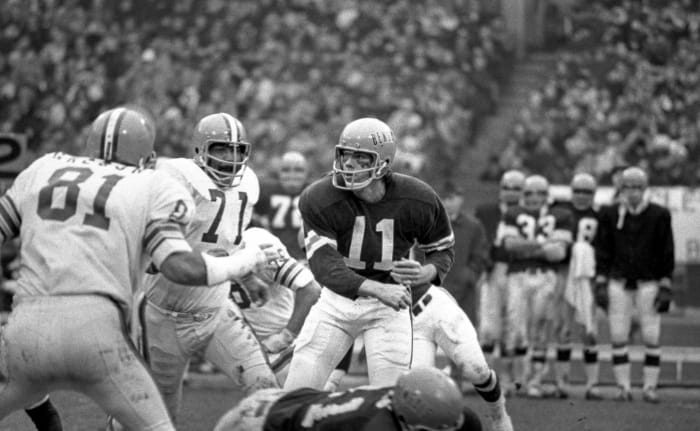
Ron Kuntz Collection/Diamond Images via Getty Images
Super-prospect Greg Cook’s shoulder injury, which keyed an early career conclusion and one of the NFL’s signature what-ifs, prompted the Bengals to make a move for Carter. In July 1970, Cincinnati claimed Carter off waivers from Buffalo and later sent a sixth-round pick as compensation. Carter became a major footnote in league history, with Paul Brown and then-Bengals assistant Bill Walsh crafting a short-passing offense around the limited QB talent. Carter made 11 starts for the 1970 Bengals, who rallied from 1-5 to the AFC Central title. Though he only spent three years in Cincy, Carter is a key piece of West Coast Offense lore.
8 of 30
Green Bay Packers/New York Giants: John Hadl and Craig Morton
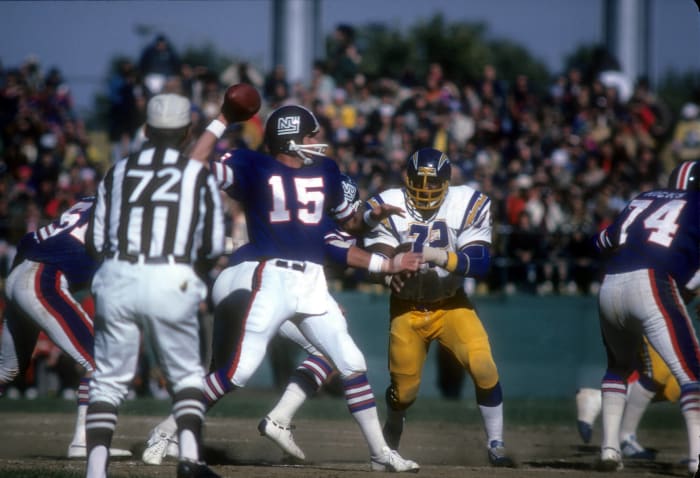
Focus on Sport/Getty Images
The 1974 trade deadline is underrated. Future Hall of Fame D-lineman Curley Culp changed teams in a deal involving future Raider D-line mainstay John Matuszak. But two trades for starting QBs occurred that day (Oct. 22). The Packers sent the Rams a monster trade package (two firsts, two seconds, a third) for Hadl, a 1973 All-Pro but an aging arm by that point. The Giants sent the Cowboys first- and second-rounders for Morton, whom Roger Staubach had usurped. The first of those picks became Hall of Fame D-tackle Randy White. Morton played that week for the Giants; Hadl debuted a week later. Both deals bombed; the QBs were elsewhere by 1976. But this made for an explosive news day.
9 of 30
New Orleans Saints: Ken Stabler

Focus on Sport via Getty Images
After making a QB1-for-QB1 swap in 1980 — Stabler for Dan Pastorini — the Raiders and Oilers went in opposite directions. The Oilers made the 1980 playoffs with Stabler, but he underwhelmed as a Houston starter. After the Oilers cut the future Hall of Famer in 1982, the Saints signed him in late August. Signed to replace injured backup Dave Wilson behind Archie Manning, Stabler — then 36 and playing under ex-Oilers HC Bum Phillips again — leapfrogged Manning and started eight of the Saints’ nine 1982 games. The Saints traded Manning to the Oilers in September 1982; Stabler started for most of 1983 in New Orleans.
10 of 30
Tampa Bay Buccaneers: Jack Thompson

George Gojkovich/Getty Images
Doug Williams’ messy contract dispute, which came shortly after his wife died from a brain tumor, led the Buccaneers starter to the USFL’s Oklahoma Outlaws in 1983. The Bucs had acquired some Williams insurance in June of that year, trading a first-round pick for ex-Bengals top-three draft choice Thompson. “The Throwin’ Samoan” started for most of the ’83 season, struggling as the Bucs plunged into a lengthy period of misery. But a 1984 trade for Steve DeBerg demoted Thompson in 1984. That 1984 pick the Bucs traded for Thompson became No. 1 overall (Irving Fryar). The Bucs cut Thompson in September 1985.
11 of 30
New Orleans Saints: Bobby Hebert
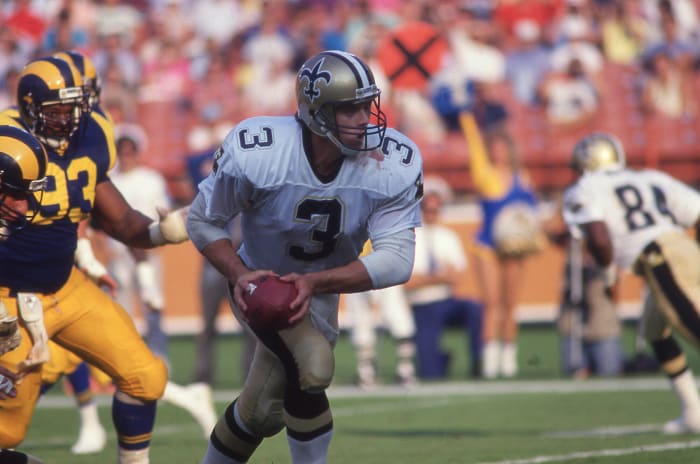
Owen C. Shaw/Getty Images
A Louisiana native, Hebert signed with the Saints in August 1985 — after he had become one of the USFL’s top players. The Saints gave him a lucrative (for the era) contract worth nearly $900,000 per year. Hebert had led the Michigan Panthers to the USFL’s first title and, after the Panthers merged with the Oakland Invaders in 1985, steered his new team to a runner-up finish that summer. He went right into an NFL training camp. Hebert closed the ’85 season as New Orleans’ starter and took over for good in 1986 when Jim Mora — who coached against Hebert throughout the USFL’s run — became the Saints’ head coach. Hebert led the Saints to three playoff berths.
12 of 30
Los Angeles Rams: Jim Everett

Focus on Sport/Getty Images
The 1986 draft saw the Nos. 1 and 3 picks never play a down for the teams that chose them. Everett’s refusal to sign with the Oilers was more traditional than Bo Jackson’s Buccaneers spurning, but Houston drafted Everett despite Warren Moon being on a then-record five-year, $5.5 million deal. After 1985 Rams starter Dieter Brock suffered a preseason knee injury, Everett went to Los Angeles for a monster trade package. This deal did not happen until late September. But Everett settled in as the Rams’ starter late in 1986 and kept the job until 1993. Everett remains the second-longest-tenured QB1 (behind Roman Gabriel) in Rams history.
13 of 30
Chicago Bears: Doug Flutie

Sporting News via Getty Images
A month after acquiring Everett, the Rams traded Flutie’s rights to the Bears for fourth- and sixth-round picks. Chicago designed the October 1986 deal to be for the future; the team had Super Bowl starter Jim McMahon. But McMahon’s injury troubles soon intensified. Soon after the Flutie trade, McMahon tore a rotator cuff. In his first game back from that injury, he was on the wrong end of one of the NFL’s defining dirty hits. The Charles Martin body-slam ended McMahon’s season, gutting a Super Bowl favorite. After using other QBs for a few weeks, Mike Ditka started Flutie in Chicago’s playoff game. The USFL star’s 11-for-31 day ended a 14-2 team’s season; Flutie never threw another pass as a Bear.
14 of 30
New Orleans Saints: Steve Walsh

Mike Powell/Allsport/Getty Images
Amid an Hebert holdout that lasted throughout the 1990 season, the Saints opted to part with major assets to replace him. In late September 1990, the Saints traded first-, second- and third-round picks for Cowboys backup Steve Walsh. A national champion QB at Miami, Walsh rejoined Jimmy Johnson as a 1989 first-round supplemental draftee. But Troy Aikman stayed on track to become Dallas’ franchise QB. Walsh took the Saints’ reins in Week 6 and kept them throughout, helping the defense-powered team to an 8-8 season and a wild-card berth. Hebert ended his holdout in 1991, and Walsh was mostly a Saints backup through 1993.
15 of 30
Dallas Cowboys: Steve Beuerlein

Focus on Sport/Getty Images
The Cowboys acquired a new Aikman back up in late August 1991, obtaining Beuerlein from the Raiders, who had banished him from their QB equation. A 1987 Raiders fourth-rounder, Beuerlein became a primary starter in 1989. Beuerlein’s decision to hold out during part of the following summer rankled Al Davis, who saw to it that Beuerlein did not dress in 1990. He became needed in Dallas. A November knee injury sidelined Aikman for the season, and Beuerlein quarterbacked the Cowboys to four straight wins to close the regular season. The Cowboys then won a wild-card game in Chicago, their 1990s dynasty’s first playoff victory.
16 of 30
San Diego Chargers: Stan Humphries

John Cordes/Icon Sportswire via Getty Images
Dissatisfied being Mark Rypien’s Washington backup, Humphries requested a trade during the team’s 1992 training camp. Eventually, the fifth-year QB got his wish via an August move to the Chargers, who had spun their wheels ever since Dan Fouts’ 1988 retirement. Bolts GM Bobby Beathard drafted Humphries when he was Washington’s GM and did not wait long to plug him into his new team’s starting lineup. Humphries overtook veteran Bob Gagliano after one game and, after losing his first three starts, steered the Chargers to an 11-5 season. These Bolts remain the only team to dig out of an 0-4 start to the playoffs, where they won a wild-card shutout over the Chiefs.
17 of 30
Dallas Cowboys: Bernie Kosar

TIM ROBERTS/AFP via Getty Images
After Bill Belichick’s controversial Kosar cut in-season, the ex-Browns QB landed with his former college coach. Jimmy Johnson, who had already rostered ex-Hurricane Steve Walsh, signed Kosar in November 1993. This move came two days after Aikman sustained a hamstring injury. On four days’ notice, Kosar replaced third-stringer Jason Garrett and led the Cowboys to three scoring drives in a win over the Cardinals. Given a $1 million deal to back up Aikman, Kosar was again needed in the NFC title game, when a concussion forced the starter to miss the entire second half. Kosar kept the Dallas sportscar on the road en route to Super Bowl XXVIII.
18 of 30
Cincinnati Bengals: Jeff Blake

Al Bello/Getty Images
Midway through their Boomer Esiason years, the Jets waived Blake — a 1992 sixth-round pick. After Blake did not make the Jets’ 1994 team, the Bengals claimed him just before the season. This transaction led to Blake extending his career to 14 seasons. Beginning the season as Cincinnati’s third-stringer, behind former top-10 pick David Klingler and Donald Hollas, Blake took over after both suffered injuries in the same game. Bumped up to start for an 0-7 team, Blake led the Bengals to back-to-back wins in his first month as a starter. His high-arching deep ball became a Cincinnati fixture for the rest of the ’90s.
19 of 30
New York Jets: Vinny Testaverde

Icon Sports Media
Back when teams needed to wait until June to save money on post-June 1 cuts, the Ravens took that route with their five-year starting quarterback (Testaverde started for Browns 1.0 and then with the Ravens). Weeks later, the Jets pounced, dumping starter Neil O’Donnell after Testaverde signed a two-year, $8.7 million deal. Testaverde’s arrival went a long way toward Bill Parcells crafting a third NFL rebuild. Two years after a 1-15 season, the Jets journeyed to the AFC championship game. Vinny, at 35, went 12-1 as a starter and finished his first year with a 29-7 TD-INT ratio. He stuck around through 2003.
20 of 30
New York Giants: Kurt Warner
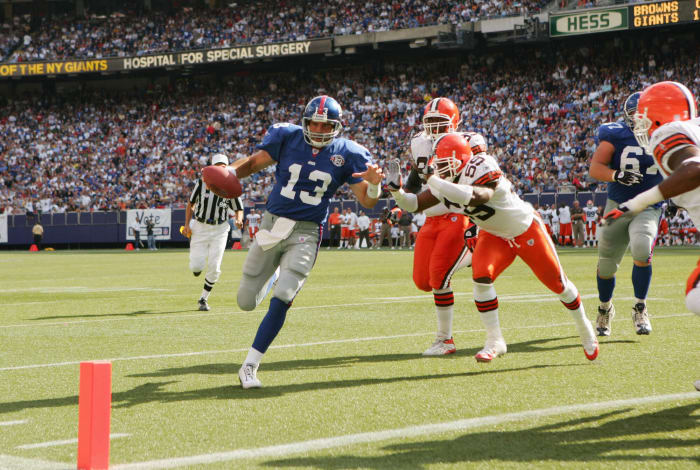
Ezra Shaw/Getty Images
Six years later, the Giants signed a future Hall of Famer to groom a QB who will likely end up there. The Rams made Warner a post-June 1 cut, leading to a deal to be Eli Manning’s bridge. This is the most overlooked chapter in Warner’s career, but it is important to remember the Rams had benched the suddenly struggling two-time MVP for Marc Bulger in 2003. Warner became the Giants’ Week 1 starter and led them to a 5-2 start. Tom Coughlin determined, despite the team’s 5-4 record, that Manning was ready. That ended up sacrificing the 2004 season, with the Giants losing Manning’s first six starts. Warner wound up in Arizona in ’05.
21 of 30
Baltimore Ravens: Steve McNair
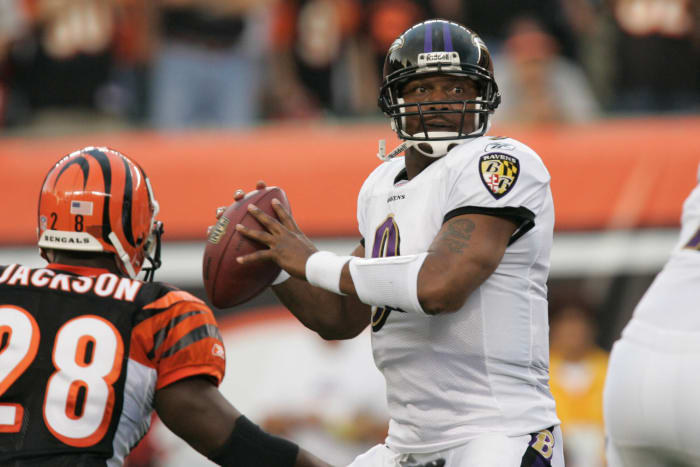
MARK COWAN/Icon Sportswire
This was a higher-profile situation than Baker Mayfield’s, at least in terms of quarterback stature, though the 2006 NFL news cycle is not what today’s is. The Titans, after drafting Vince Young, barred McNair from their offseason workouts. McNair had to win a grievance to re-enter the team’s facility. Tennessee moved on from its only Super Bowl QB after 10 seasons, sending McNair to Baltimore for a fourth-round pick in June. The trade helped the Titans for cap purposes, and the deal — for one year, at least — solved a Ravens QB dilemma. McNair had the Ravens at 13-3 in 2006. A 2007 injury ended up wrapping his career.
22 of 30
New York Jets: Brett Favre

Jesse Beals / Icon Sportswire
Probably the most famous late-arrival QB situation involved Favre’s first unretirement. After Favre re-emerged in July 2008 by indicating he wanted to come back for an 18th season, a weeks-long soap opera overshadowed the NFL’s 31 non-Packers teams and began Aaron Rodgers’ QB1 career on shakier-than-expected terrain. The Brett-or-Aaron debate ended with the Packers sending Favre to the Jets in August for what became a third-round pick. Favre’s iron-man streak included 16 Jets starts, but a biceps injury led to the Jets falling from 8-3 to 9-7. Retirement No. 2 commenced, completely ending Favre’s NFL odyssey. …
23 of 30
Miami Dolphins: Chad Pennington

Gary Rothstein/Icon Sportswire
The Packers discussed a deal with the Buccaneers as well, but the Favre-Jon Gruden pairing not coming to pass meant Pennington was out of a job. The Jets, who had benched their six-year starter for 2006 second-rounder Kellen Clemens in 2007, cut Pennington a day after they acquired Favre. On August 11, the Dolphins signed the veteran starter to a two-year, $11.5 million deal. This turned out to be the last dance for Pennington. He made it memorable by leading a Dolphins nucleus that went 1-15 in 2007 to the AFC East title. A second Comeback Player of the Year award came Pennington’s way in ’08, but injuries nixed an encore.
24 of 30
Minnesota Vikings: Brett Favre
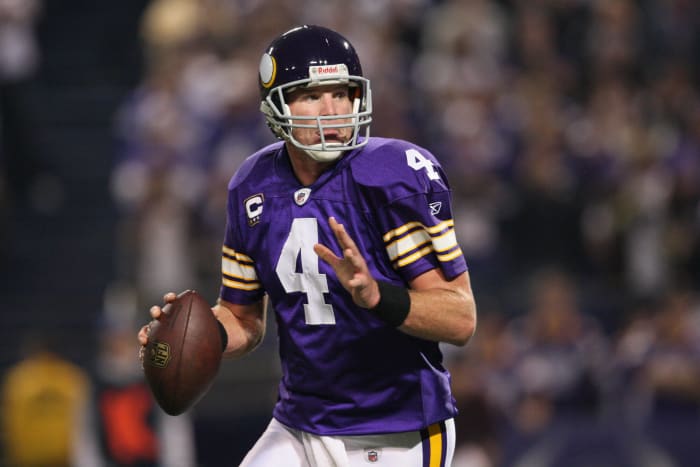
Rich Gabrielson/Icon Sportswire
Upon trading Favre to the Jets, the Packers included a poison-pill provision that would send three Jets first-rounders to the Packers if they traded Favre to the Vikings. This led to the Jets relinquishing Favre’s rights after he re-retired. The Vikes, who were closely linked to Favre in ’08, waited a year and received a much better version of the all-time great. After Favre told the Jets he was done in February, his August Minnesota signing keyed the best Vikings season this century — a 13-3 campaign that ended on the Super Bowl XLIV precipice. Favre threw 33 TD passes and just seven INTs, though a costly playoff pick still lingers.
25 of 30
Oakland Raiders: Carson Palmer

Richard C. Lewis/Icon Sportswire
Frustrated with the Bengals’ offseason minimalism, Palmer took a bold step and staged a quasi-retirement to initiate a divorce. A seven-year Cincinnati starter, Palmer ended up sitting out nearly half the 2011 season. But Raiders starter Jason Campbell’s injury pulled Palmer out of retirement. Oakland sent first- and second-round picks to Cincinnati for Palmer on Oct. 18. The Raiders threw the 31-year-old QB into the fire five days later. After the team’s bye week, Palmer took over as Oakland’s full-time starter. His 1 1/2-season Raider tenure proved uneventful. The Bengals drafted Dre Kirkpatrick and Gio Bernard with the Palmer picks.
26 of 30
Minnesota Vikings: Sam Bradford

Larry Radloff/Icon Sportswire
Part of a 2015 trade that sent Nick Foles to the Rams, Bradford became an Eagles one-and-done after Teddy Bridgewater’s career-threatening injury. The two-year Vikings starter suffered a dislocated knee and torn ACL during training camp, and the Rick Spielman-Mike Zimmer regime traded first- and fourth-round picks for Bradford in early September. Bradford became essentially a one-and-done Vikings starter, too, with injuries halting him in 2017. While the Vikes went 8-8 in 2016, Bradford set a then-single-season completion percentage record (71.6). The deal also paved the way for Carson Wentz to start from the jump in Philly.
27 of 30
Miami Dolphins: Jay Cutler

Doug Murray/Icon Sportswire
After 11 seasons, eight with the Bears, Cutler retired in May 2017. Ryan Tannehill’s ACL tear pulled the rocket-armed passer away from a FOX deal and into the saddle in Miami. This deprived viewers of seeing how the oft-apathetic Cutler would fare calling games. It led to a forgettable NFL finale. Cutler, then 34, signed a one-year, $10 million deal to rejoin ex-Bears offensive coordinator Adam Gase with the Dolphins. While Cutler lasted 14 games, Miami went 6-10. Cutler re-retired after the season, and although he made some reality TV appearances, he has not ventured into the booth as originally planned.
28 of 30
Indianapolis Colts: Jacoby Brissett

Jenna Watson/IndyStar, Indianapolis Star via Imagn Content Services, LLC
If/when Brissett starts Browns games, he will likely receive far more notice of those plans than he did ahead of either of his Colts QB1 years. Andrew Luck’s nagging shoulder injury overshadowed everything Colts in 2017; the September trade Indianapolis made for New England’s former third-stringer turned out to be significant. Traded straight up for first-round wideout Phillip Dorsett, Brissett replaced Scott Tolzien in Week 1 and made the final 15 starts for that Colts squad. After Luck returned in 2018, his August 2019 retirement moved a better Brissett version back into the lineup. Deshaun Watson’s backup/fill-in has 37 career starts.
29 of 30
San Francisco 49ers: Jimmy Garoppolo

Sergio Estrada-USA TODAY Sports
While the 49ers have long been ready to cut this cord, Garoppolo bailed out a Kyle Shanahan-John Lynch regime that passed on Watson and Patrick Mahomes in 2017 to take defensive lineman Solomon Thomas. San Francisco went into the 2017 season absent a viable QB1 and acquired Garoppolo — whom the Patriots did not make available until the 2017 deadline — for a second-round pick. The 49ers still started C.J. Beathard for three games before determining their new QB was ready. The 49ers went 5-0 under Garoppolo and 1-10 with their other passers that year. That pattern continued for the next four seasons.
30 of 30
New England Patriots: Cam Newton

JAMIE GERMANO/ROCHESTER DEMOCRAT AND CHRONICLE via Imagn Content Services, LLC
A minimal market formed for Newton in 2020, after the former MVP had missed almost all of 2019 with a foot injury. The Patriots, who gave the football-viewing public the impression for weeks that Jarrett Stidham was a legit starter option, went with Newton from the jump. Coming when the Pats saw several cogs opt-out due to COVID-19 concerns, the Pats’ 2020 slate featured a severely diminished Newton. While his rushing chops remained, the ex-Panther superstar threw eight TD passes in 15 starts. The Pats winning seven games with Newton did not prevent them from a viable first-round QB (and Cam’s eventual replacement) in 2021, however.
[ad_2]
Source link




